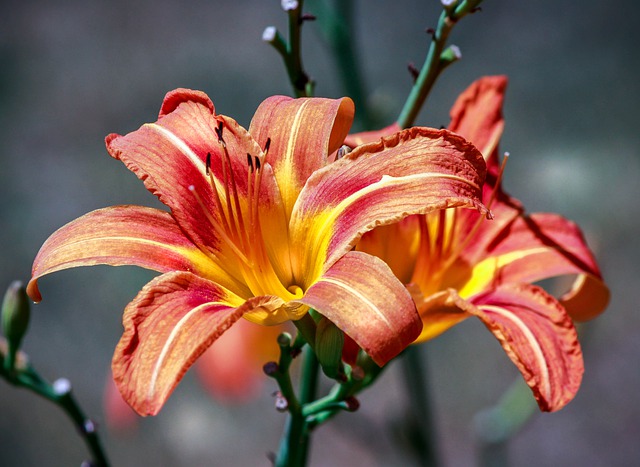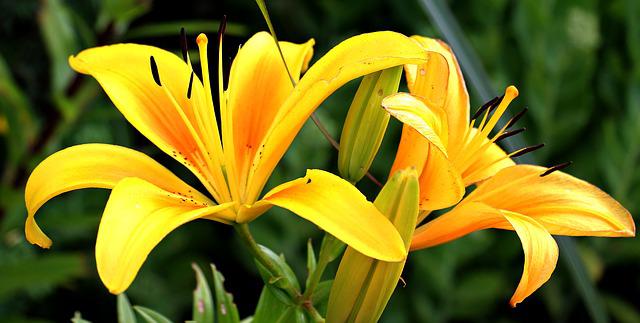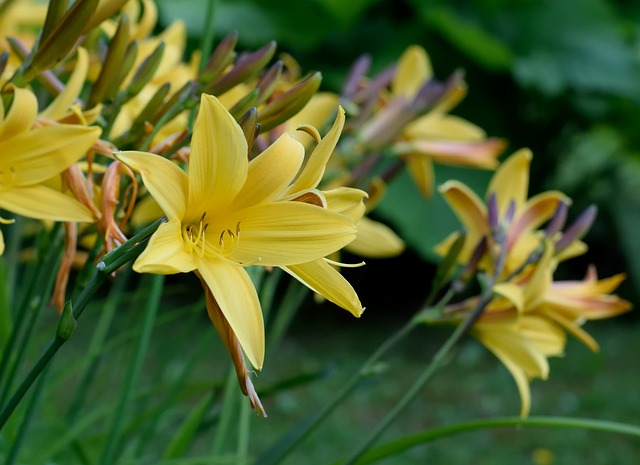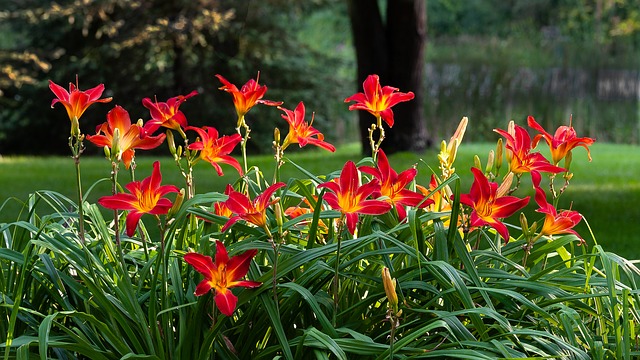Daylily Vs. Lily: What is the Difference Between Them? Differences Explained!

Do you want to know the difference between a daylily and a lily? If so, you’ve come to the right place! This article will detail the key differences between these two types of flowers to make an informed decision, especially if you are trying to learn how to grow the one you already have or are just curious about why you cut lilies die when you bring them inside. You’ll need to know the difference between lilies and daylilies!
Table of Contents
Flowers
Daylilies
There are many different shapes and sizes of daylily flowers, including double and ruffled, circular and triangular, star-shaped, and spider-shaped. When you look closely at the end of the pistil of a daylily, you can see that it is slightly curved and has three tubes joined together.
Daylilies usually have trumpet-shaped flowers that open outward. They also have petals that flake. People make different kinds of plants, and some of them have ruffled petals and flowers that look like a star or a spider. It is possible to get daylilies in a wide range of colors, such as shades of yellow and orange. They have more than one color.
Lilies
The petals and anthers of a lily are always six, as is the standard for all lilies. Each bloom can last up to a week or more, depending on the variety. Cut lilies, such as true lilies, are very popular. The stem’s lowest buds will open first, then the remaining buds up to the very top. Consider removing the anthers if you bring your lilies indoors. The thick pollen can stain anything it comes into contact with or is blown onto.
They also come in various shapes, including recurved, trumpet-shaped, and bowl-shaped. Its stigma has a broad, flattened end that resembles a match stick for redheads, and its style is straight and simple. They also come in various shapes, including recurved, trumpet-shaped, bowl-shaped, and funnel-shaped. Lily flowers are also available in many colors.
Leaves
Daylilies
Daylilies’ blades are long, flat, strap-shaped, and grow in clumps from the plant’s crown at the soil line. Leaves are formed from a mound of long, strappy roots that grow from the ground. They will always have green growth above ground, regardless of the season.
Lilies
The leaves grow in whorls or spirals around the entire stem length, covering the entire surface area.
Underground Storage Structures
Daylilies
Every daylily has a tuberous root system that connects to a crown and the leaves.
Lilies

Liliums are all borne on a single upward-growing stem from scale-covered bulbs. Some Liliums have both basal and stem roots, and some have both. The bulbs are either concentric or stoloniferous, which means they have scales and roots attached to a basil plate. Both types have scales and roots. The stoloniferous type uses stolons. These stolons grow below the ground surface and can be seen by people. This is how the mother plant sends nutrients to its stolons or underground runners to grow new Lilium bulbs for its daughter plants.
When Liliums are split up, they are split up by bulb offsets or bulb scales, called bulb scaling. When daylilies are split up, they are split up by cutting through a hard white core called the daylily crown, which is between the roots and leaves.
Growing Habit
Daylilies
Daylilies produce plantlets or proliferation on the stems of their flowers. It’s always a daylily if it has multiple stems with strapping leaves growing from the base. The flowering stems of daylilies are hollow and devoid of leaves.
Lilies
A true lily will always have a single stem with whirling leaves from which the flower buds emerge at the top. In contrast to other Lilies, Tiger Lilies reproduce by producing brightly colored aerial bulbils on their stems while they are in bloom, shiny and black. Tiger lily flowers are bright orange with black dots on the petals that face downward. Numerous flowers bloom on the stem’s upper one-third.
Height
Daylilies
Daylilies are typically composed of a clump of arching, grass-like leaves that grow from a common base. The foliage is a light to dark green hue and grows to 18 to 24 inches (1.5-2 feet), depending on the variety. Flower stalks emerge from the plant’s center and can reach a height of 12 to 48 inches (1-4 feet), with multiple stalks per plant.
Lilies
The tiger lily is an attractive and unusual plant. They grow up in height from about one and a half feet to a towering ten feet, vertically extending dark green leaves with a long, lance-shaped shape are found on the stems of this plant. Young plants have only one stem, whereas older plants can have several stems simultaneously.
Bloom Time

Daylilies
Daylilies are a favorite of hybridizers, with over 30,000 varieties named. Each flower blooms for a single day, so daylilies are ineffective as cut flowers. Hemerocallis derives its name from the Greek words “hemera” (day) and “kallos” (beauty). Flowers are produced on slender stalks called scapes that grow from the plant’s base. Multiple-branched scapes are possible.
Lilies
Each flower lasts for a week or more. True lilies are very popular for cutting. The buds at the bottom of the stem will open first, and the rest of the buds will open one by one until they reach the top of the stem. If you bring your lilies inside, you might want to remove the anthers. Stains can be caused by thick pollen.
Edibility and Toxicity
Daylilies
The flowers are safe to eat. They can be used in a wide range of dishes, and the plant’s various components can be used in various ways in the kitchen. As an example, you can eat the buds and flowers and the shoots and tubers. When served with other vegetables, steamed or sauteed daylily shoots are a delicious side dish.
Daylilies are good for you and beautiful to look at. More protein, vitamin C, and vitamin A are found in daylily buds than in green beans or asparagus, and they also have the same amount of vitamin A as asparagus. Two carotenoids, good for your eyes, give the wild daylily (Hemerocallis fulva) its bright orange color. To prevent macular degeneration and cataracts, lutein and zeaxanthin may be beneficial.
Lilies
You should avoid handling or drinking anything related to lilies because they are poisonous in every way possible. In less than three days, your cat can die from kidney failure caused by eating even small amounts of leaf or flower petals, licking a few pollen grains from its fur, or drinking the water from the vase. A poison that only affects cats has not been discovered yet. Although dogs may experience minor stomach upset after eating lilies, they do not suffer from kidney failure.
Drooling, vomiting, and a general lack of interest in food are all early signs of a cat’s sensitivity to lilies as a toxin. Symptoms can begin within the first 0 to 12 hours of ingestion. After 12 to 24 hours of consumption, signs of kidney damage appear, including increased urination and dehydration. Cats with kidney failure die within 24 to 72 hours unless treated. The prognosis of a sick cat can be greatly improved by seeking veterinary care as soon as possible. The cat will suffer irreversible renal failure if treatment is delayed for 18 hours.
Garden Use
Daylilies
It is possible to use daylilies in various ways, including as ground covers, borders, edgings, and rock gardens. Containers are a great place to grow dwarf varieties.
Plantings of daylilies can serve a practical purpose as well as being ornamental. To keep weeds at bay, use daylilies that have been strewn across the ground. They can be used to keep people from wandering off the designated paths. They thrive in difficult areas, such as steep banks, that are difficult to mow. Even as fire breaks, daylilies have proven their worth.
One of the most common uses for daylilies is in mixed borders, which are plantings that “border” various things such as paths or fences or terraces or pools or lawns or hedges, or curbsides. Planting beds can be of any shape, formal or informal, and often include a mix of woody plants, bulbs, perennials, and annuals in their plantings. Daylilies with successive bloom times are ideal for gardeners who want something blooming for most of the growing season.
Impulse purchases can be accommodated with mixed borders. An attractive plant can be purchased at the garden center and brought home to fill in an open area of the garden with ease. Because of their arching grassy foliage and wide range of flower colors, they can be used in various settings.
Foundation plantings can also include daylilies. Their foliage blends well with shrubs such as evergreens, rhododendrons, and boxwood commonly planted in the area. Daylilies can be tricky for foundation plantings because of their wide range of colors. Flowers that match or contrast in color with the house are a good choice. It’s best to avoid bright orange daylilies when planting daylilies next to a house with light blue siding.
Lilies
Tiger lily gives borders and backgrounds a stately air. It works well in front of tall evergreens or as a backdrop for smaller flowering plants.
Lilies can be used as focal points or accent plants. As an accent plant, the lily you choose should have strong plant strength and foliage and flower color that will blend in or stand out against the rest of the landscape. It would be appropriate to use accent plants in various places around the garden, such as in the center of small flower beds, along garden fences, or near an entrance driveway, among other places. On the other hand, Accent lilies should be able to put on a real show as a single clump and stand out in both foliage and flower.
Perennial borders allow for the most variety in terms of height, color, and season of bloom in terms of the plants they contain. The low-growing lilies should be placed at the front, and the taller lilies should be placed at the back. The use of white lilies to divide the pink, yellow, and orange groups helps avoid color clashes. A few taller, later-flowering lilies can be scattered throughout the landscape. Each cultivar can be planted 15 to 19 inches apart, depending on the size of the garden border. This will allow for mulching and weeding. The perennial border design can be aided by using Table 1’s classification of lily cultivars.
Summary of Comparison:
| Daylilies vs Lilies | |
| Daylilies | Lilies |
| Hemerocallis | Lilium |
| -grow from tuberous roots | -grow from bulbs |
| -make two layers, three petals on top and three sepals below | -always six petals |
| -plant’s leaves resemble grass blades growing from a clump | -possess leaves that extend the entire length of the central stem. They will take on the shape of whorls or spirals. |
| -they reach a height of around 3-4 feet | -can reach a height of up to 10 feet |
| -the blooms last only one day, thus the name, and are therefore unsuitable for bouquets | -are frequently used as cut flowers because their blooms last up to a week |
| -edible blossoms | -flowers are poisonous, particularly to cats |
| -they can have up to 50 blooms on each stem | -have 3 to 5 flowers on each whorl, and they are usually white, pink, yellow, or red. They can also have black spots on them, though. |
| -flowers are not sold in florists or nurseries as cut flowers | -flowers are sold in supermarkets and on the internet as cut flowers |

